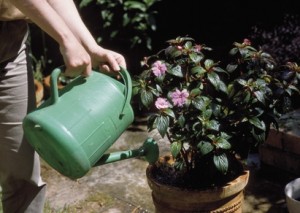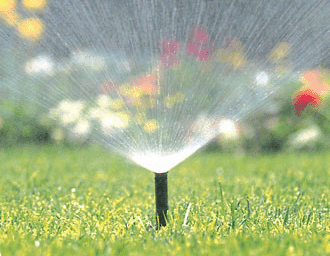Annuals
 If you used a slow release fertilizer in the spring to fertilizer your annuals, now is the time to reapply. These fertilizers have a four month life span, so this application will take you through the remainder of the growing season. Pay close attention to plants in containers as they will dry out faster than will plants in the ground. Many annuals will need to be dead-headed to keep them blooming. Pinch back coleus and impatiens to keep them from becoming leggy.
If you used a slow release fertilizer in the spring to fertilizer your annuals, now is the time to reapply. These fertilizers have a four month life span, so this application will take you through the remainder of the growing season. Pay close attention to plants in containers as they will dry out faster than will plants in the ground. Many annuals will need to be dead-headed to keep them blooming. Pinch back coleus and impatiens to keep them from becoming leggy.
Turf
 This is not the time to try to establish a new turf area. Watch for damage from mole crickets, beetles, and chinch bugs. Be sure to vary mowing patterns and keep grass cut a little higher now because of the heat. Check irrigation systems for leaks or needed repairs, and make sure heads haven’t become misaligned: This can create dry spots in the lawn that will quickly lead to dead areas.
This is not the time to try to establish a new turf area. Watch for damage from mole crickets, beetles, and chinch bugs. Be sure to vary mowing patterns and keep grass cut a little higher now because of the heat. Check irrigation systems for leaks or needed repairs, and make sure heads haven’t become misaligned: This can create dry spots in the lawn that will quickly lead to dead areas.
Perennials
Reapply slow release fertilizers to perennial plants now, too. If you have perennials that have finished blooming, you can often get a second bloom period by dead heading them now. This will cause them to bloom again during the late summer. Keep an eye out for aphids, spider mites, and other heat loving insects during this month. Treat with a systemic insecticide for best results.
Roses
 Do not fertilize roses this month. However, if you have Knockout Roses, they can be cut back by a third to encourage new growth and set an intense display of blooms. Japanese beetles can be a nuisance on many plants including roses at this time of year. There’s an easy way to take of them: Take a jar of soapy water (dish soap will do) out to the plants that Japanese beetles are feeding on. Hold the jar beneath the beetles and tap gently on the plant. The beetles will react by dropping off the plants and fall into your waiting jar of soapy water where they will die. This can be done a couple of times a day for the short time that Japanese beetles are feeding on your plants.
Do not fertilize roses this month. However, if you have Knockout Roses, they can be cut back by a third to encourage new growth and set an intense display of blooms. Japanese beetles can be a nuisance on many plants including roses at this time of year. There’s an easy way to take of them: Take a jar of soapy water (dish soap will do) out to the plants that Japanese beetles are feeding on. Hold the jar beneath the beetles and tap gently on the plant. The beetles will react by dropping off the plants and fall into your waiting jar of soapy water where they will die. This can be done a couple of times a day for the short time that Japanese beetles are feeding on your plants.
Shrubs
Little or nothing should be done to shrubs now. It’s a good time to note which shrubs may need to be replaced in the fall when planting times comes around again. Many conifer type shrubs are susceptible to spider mites during hot, dry summer months, in particular Dwarf Alberta Spruce. These can not easily been seen until they’ve caused irreparable damage. Monitor closely for webbing or discoloration of plants.





